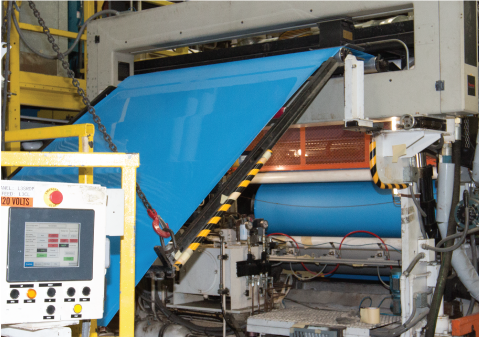As a custom extruder specializing in concept to commercialization, we provide clients with insight into our cost drivers to help them make an informed decision about working with us. Although every custom solution is different, we strive to propose a cost estimate that is as accurate as possible before a project begins.
Our costs are driven by these three main factors:
- Materials
- Throughput/Run Rate (the speed at which we run our equipment)
- Run sizes
1. MATERIALS
The cost of the raw material inputs are a significant driver of the cost of the extruded film or sheet solution. Ultimately, the cost of the raw material is directly related to the cost of the extruded sheet or film. Because we can also extrude onto films and fabrics, the cost of the polymers, films, and/or fabrics that are required to meet the customer’s performance specification will dictate the cost of the extruded, laminated solution. Although this explanation regarding cost drivers may seem obvious, it’s an important detail for our clients to consider before a project begins. For highly cost-sensitive requirements, the expense related to materials will drive the decision for choosing the best materials to use for the solution. If our client is seeking a cost-sensitive construction, we will not propose a premium, performance-driven structure.
The following sections will review the implications that material selection has on run rates and scrap costs.
2. THROUGHPUT/RUN RATE
Bixby is compensated for conversion of thermoplastic pellets into thermoplastic film or sheet, and our goal is to maximize the run rate or the pounds per hour that we can extrude through our equipment. We have several different screw designs that we employ in order to optimize rates. As the application demands, we routinely change screws as we switch from job to job. Theoretically, we can extrude the same pounds per hour for thick sheet or thin films across all thermoplastic materials. However, in reality, there are many variables that will affect the extrusion rate.
Viscosity or melt flow of the material can have an impact on throughput. For example, if the application requires a certain polymer which has a high viscosity and we have to put a lot of sheer heating into the system with the screw, then the amps on our motors would likely increase and we may not be able to get production rates anywhere near the nameplate rate on our extruders. As a result, we would have a rate that is slower than normal.
Cooling requirements can also affect the production rate of a project. The thickness of the film, its inherent melt strength, and our ability to cool the material as we handle it and wind it up will all impact the extrusion rate. We are taking a polymer, making it molten so we can pass it through our die and form it into a thermoplastic film or sheet. After that, we cool it down until it forms a solid so it can be wound up on a roll or cut into sheets. These factors are why it is crucial to understand the performance requirements and the implications on material selection and throughput before the start of any project.
If the construction is multilayer and is difficult to get adhesion of the layers, then we may need to slow down the line to keep things warmer longer in order to improve adhesion. This scenario would increase the cost because the run rate would be slower.
Many additional factors and combinations of factors can affect the throughput. Typically, we know the impact of these factors after a production trial and can give very accurate pricing at that time. Before that, we are quoting budgetary pricing numbers.
3. RUN SIZES
The extrusion run size has a huge effect on cost, especially as run sizes get smaller and smaller. This is because our set-up costs and startup waste are essentially fixed. Whether we run one unit or a million units, the set-up cost and startup rate are the same. If we can spread these costs over a reasonable number of units, then the per unit cost impact is driven down. New clients have often asked what our minimum order quantity is – the answer is dependent on the client’s budget. However, in general, our goal is to achieve a production run of at least 10 to 12 hours. On average, this works out to roughly 5000 lbs. of extruded thermoplastic. This is the point where the dilution of the startup and set-up costs become reasonable on a per unit basis.
As run sizes increase, the process becomes more and more efficient and the waste factor is driven toward zero. Because we have clients with very differing needs, we will work with each of them to deliver the best solution for their project. Some clients have a very small demand for a high value specialty product and the application can support these higher conversion costs on a per unit basis. Other clients with very high volume demand also enjoy the benefit of this very efficient production scenario.
Additionally, the run size and demand can be balanced by carrying inventory. In general, Bixby is a make-and-ship organization – however, with an appropriate agreement in place, we do carry inventory for our clients so that run sizes can be optimized. There is also a cost related to carrying inventory but, in general, this expense is much smaller than the waste and startup costs associated with very small extrusion runs.
There are other factors that also impact the overall cost such as the ability to regrind and reuse the scrap that gets generated during a project. Although we always try to reuse any waste that is generated during a project, there are certain products such as medical applications where the inclusion of regrinding is prohibited. Also, if we are extruding a multilayer structure and then generally mixing two dissimilar materials in a waste stream, this makes it unusable as a regrind stream.

